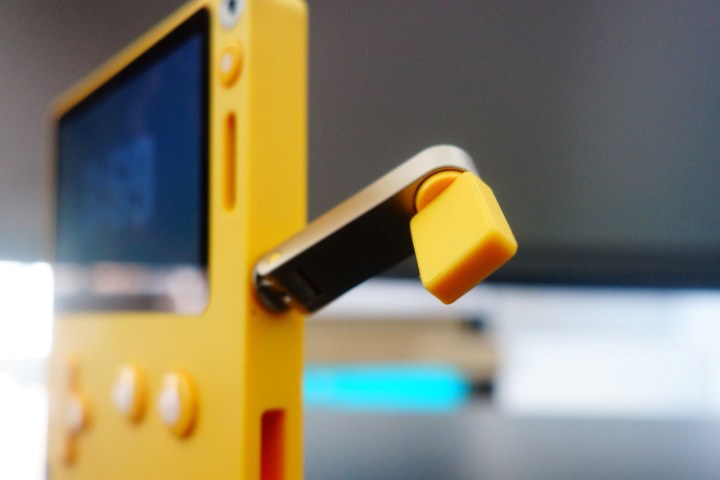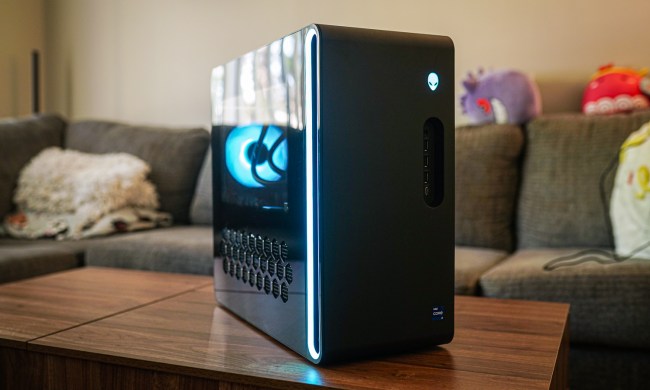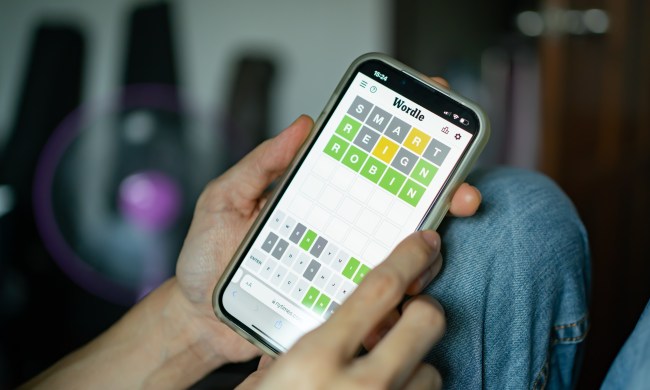Panic’s Playdate handheld is unlike any other video game system. It has ample storage and supports Bluetooth, but also has a 400 x 240, 1-bit monochrome display and a crank on the side of the system. New platforms are always a risk to invest in, especially when they are as weird and gimmicky as Playdate.
Despite that, Panic attracted some top-tier indie talent to make games for the system’s launch. From the man who created the iconic interactive Mario face in Super Mario 64 to the studios behind great titles like The King’s Bird and Backspace Bouken, plenty of developers are already testing the limits of what this cranky handheld can do.
Digital Trends spoke to three developers who created Playdate games ahead of its launch to discover what drew them to the system. I learned that making games for this quirky handheld is just as weird and fun as it seems as developers break new ground on a platform that’s unlike anything before it. Whether it’s figuring the right way to use that peculiar crank or finding out what being a third-party developer for the Playdate looks like, early adopters are writing the system’s first design rulebook.
Getting invited to the Playdate
Giles Goddard, the CEO of Chuhai Labs, helped create some iconic Nintendo games like Star Fox and Super Mario 64. Still, he was surprised when he first learned about the Playdate at BitSummit, a Japanese indie game event. When Nick Suttner, head of publishing at Panic, “discreetly” approached Goddard with the device, he was instantly intrigued.
“It was such a unique and cute-looking thing that we all became quite enamored by it!” he said. “The crank, super-crisp screen, and size make it the sort of device that you want to just pick up and play with all the time. So we wanted to make a simple game that you could pick up and play a few minutes at a time.”

Now that Goddard was on board with creating a game for this crank-wielding handheld, Chuhai Labs had to decide what to make. The Japanese studio held a Game Jam where its developers would come up with ideas and then vote for the game they wanted to make. During this process, Goddard recalled a surfing minigame called California Games for the Atari Lynx that he and his brother loved.
“It was the sort of game that you couldn’t really put down — it was wickedly addictive and very well made,” Goddard recalls. “The surfing game became a kind of obvious choice to use the crank on as it let you do something completely unique with the controls. I doubt we would have made it if it wasn’t for the Playdate.”
“When the opportunity to be truly hardware-driven presented itself to us, it was a brand new challenge that really intrigued us.”
Goddard would ultimately serve as lead programmer on this game, titled Whitewater Wipeout. It’s a simple, arcade-style surfing game where players perform tricks with the crank as they dodge a shark and try to get a high score. Players will get it as part of season 1 of Playdate’s game releases, which Panic recruited other notable developers for.
A fresh challenge

Suttner also approached Serenity Forge, a boutique indie game developer and publisher behind titles like The King’s Bird and Where the Water Tastes Like Wine. Chief Business Officer Kevin Zhang said Serenity Forge agreed to develop for Playdate because they liked Panic and saw this as a way to experience the challenges of an era in which Serenity Forge did not exist.
“We’re a relatively young studio compared to ones out there who have been around for many decades, so we never really had to deal with immensely difficult technical restrictions to the scale of what developers in the ’90s and early ’00s had to deal with,” he explained. “When the opportunity to be truly hardware-driven presented itself to us, it was a brand new challenge that really intrigued us.”
Serenity Forge was particularly interested in the Playdate’s crank, but had trouble coming up with an idea for an entire game as “a lot of these ideas were only good for mechanics, not an entire game design,” according to Zhang. Ultimately, the team became attached to an idea that “revolves around the frantic yet precise movements of the crank,” as players shuffle characters up and down elevators.
While the game initially featured humans, the idea came into its own when Serenity Forge decided to change the characters to penguins that Zhang says are a better fit for the “quirky, fun nature of the Playdate.” This game would become Flipper Lifter, a Playdate season 1 title that Zhang produced. He also provided the voice of the penguins.
While Panic invited Chuhai Labs and Serenity Forge into the Playdate development ecosystem, RNG Party Games started developing for the Playdate after seeing a viral tweet and filling out a form to voice their interest. Like Zhang, the three-person team behind the typing dungeon-crawler Backspace Bouken was intrigued by the retro-like hardware.
“The fact that they were making a piece of hardware that was similar to retro hardware but not restricted by the same technical limitations was appealing,” programmer and designer Jake White says. “There’s a bit more processing power, but it’s still black and white with simple controls. I have always been interested in making retro games, so that really drew me in.”
“No one really knows how to publish games for this thing, so why don’t we just try and be the first?”
Once RNG Party Games games got access to development tools, it prototyped lots of ideas but scrapped many of them. Eventually, RNG Party Games returned to an idea it’d had for a while: A real-time idle game where players tend to a garden. This concept became Bloom, a narrative-driven game that plays out in real time where players manage a flower shop, garden, and text their family. Bloom is one of the most ambitious launch games for the Playdate as it asks players to return to it day after day. Writer, musician, and artist Ben Bushe also believes that Bloom’s real-time setup “works really well in conjunction with the season of games since they’re both encouraging you to check the Playdate regularly.”

Bloom isn’t part of Playdate’s season 1 lineup. If someone wants to play Bloom, they’ll need to buy it on itch.io and sideload the game. There’s no guarantee of success, especially since the team didn’t know about the Playdate’s upcoming in-system store until it was announced on April 19. However, RNG Party Games was still excited to create something for the Playdate and help set the standard for what third-party games on the system can look like.
“It’s been like the Wild West for the past couple of years,” White asserted. “No one really knows how to publish games for this thing, so why don’t we just try and be the first? Maybe we’ll stick the landing; maybe we won’t.”
Crank-minded development

Now that these indie developers had ideas for games, they had to follow through with making them based on Panic’s Lua-based programming language. Because of the Playdate’s aforementioned technical oddities, Goddard says he was “focusing more on the gameplay aspects” when prototyping and developing Whitewater Wipeout. He says the first prototype for Whitewater Wipeout “was just a single line acting as the wave with a simple board sprite being controlled by the crank” because he knew he wanted the crank to be the primary input. That definitely wouldn’t cut it for the final release, though, and Chuhai Labs had to find a way to make the game run smoothly on this handheld.
“It can be hard keeping the frame rate fast enough for the action to be smooth, especially when you have lots of sprites appearing on screen, so sometimes you have to think outside of the box when it comes to how to do things,” Goddard explained. “For instance, because the surfboard is quite large and can be rotated to any angle, we actually prerender all the orientations to separate images when the game boots up. That frees up tons of CPU to do other things like physics or drawing sprites.”
It’s a throwback to design considerations that developers haven’t had to account for since the Game Boy. Still, these hurdles make the games that ended up on the Playdate all the more impressive. In fact, Serenity Forge’s Zhang called these limitations “freeing” while discussing the development of Flipper Lifter.
“Flipper Lifter would have never been made without the crank.”
“There’s a lot of interesting technical challenges that apply to handheld consoles, and even more so when it comes to Playdate in particular,” Zhang explained. “But in a way, it’s also really freeing because we have a much more clear idea of what is and isn’t feasible for a device like this, and it allows us to concentrate on distilling the best ideas to their purest concepts, which is always a great creative exercise.”
Like Goddard and the Chuhai Labs crew, Zhang admits that the Playdate’s crank was the “entire source of influence and inspiration” for Serenity Forge during Flipper Lifter’s development. “Flipper Lifter would have never been made without the crank, not because it wouldn’t be a fun game, but because there are so many other fun games we could have made that wouldn’t have revolved around the idea of being able to use such a unique input without getting too tired of it.”
Bloom bucks that design trend just as it bucks the release trend. It uses the crank for an elevator and scrolling through texts, but it isn’t the game’s main focus. It even features an accessibility mode that relegates crank functionality to the D-pad. “If all the season 1 games are going to be focusing on the crank aspect of it, then it’s not necessarily that important that we make it a primary mechanic,” RNG Party Games’ Peyton Balasko explains.
“Bloom’s best input device is time,” White adds. The three-person team also explained that playtesting was tough because they only had one device to share. Playing it on the system also helped them realize they needed to enlarge and make everything in Bloom readable on the system’s tiny screen. In total, White estimates Bloom took around seven months to create.

Game development is very time-consuming, with most AAA games now taking three to five years to create at minimum. As indie games become more and more ambitious, they’re starting to take just as long to make. Our discussions clarified that indie developers could make Playdate games in much shorter time frames with small teams despite unique technical challenges. A group of 10 at Chuhai Labs created Whitewater Wipeout in about a month while only working on it as a side project.
Meanwhile, Flipper Lifter’s development took about a year, but Zhang admits that Serenity Forge worked on the game on and off, so the development truly only lasted about two months. While their time developing titles for the system was short, everyone we spoke to seemed eager to make more games for the Playdate.
What’s next?
Although Panic’s system and its audience are still relatively unproven as the Playdate rolls out to those who pre-ordered it, everyone Digital Trends spoke to seemed excited to develop more games for the platform. Goddard even revealed that Chuhai Labs has already finished development on a follow-up to Whitewater Wipeout.
“We’ve already finished a new game — this time using a snowboard instead of a surfboard,” Goddard says. “I’d love to continue making games for the Playdate as it’s such a fun device to develop for.”
Goddard teased that Chuhai Labs is exploring the Playdate’s 3D capabilities. “As for untapped potential, we discovered it can actually render 3D pretty well at a decent frame rate, so I’d like to explore that more. I’m not saying you’ll see Star Fox on it any time soon, but …” he teases.
“I think the ideas are just limitless for this thing.”
Meanwhile, the system’s accelerometer is what intrigues Serenity Forge. “We didn’t get a chance to play around with its accelerometer feature and capabilities, which we think could be a great opportunity to work in conjunction with the crank,” Zhang said.
While Chuhai Labs and Serenity Forge have the relative safety net of being delivered to all Playdate players through season 1, RNG Party Games has more to prove with Bloom. While the team voiced interest in releasing future Playdate games through Playdate seasons or on Catalog, Bloom’s atypical release has not dissuaded them from being a third-party developer for the system.
“We have so many ideas!” White says. “This is the coolest machine to make games on that I’ve personally experienced. It creatively hits all the right notes. I think the ideas are just limitless for this thing … I’m excited to see meatier games because the Playdate has a huge battery and is super portable. I really want to see someone make a huge RPG that you can sink tons of hours into.”
Despite its unproven nature, Panic attracted many notable indie developers to release games for the platform and convinced them to continue working on it. The system presents unique technical and design challenges that these developers can’t find elsewhere, making for fun side projects rather than tentpole games the teams must rely on to survive.
In its current state, Playdate is a platform tailor-made for indie developers to experiment and create in. As such, indie developers big and small are checking out what all the fuss is about in between releases for more standard platforms.
Developers like Papers Please’s Lucas Pope have already announced games for the system, and its development tools are available for interested programmer.a As such, the Playdate will likely be home to some ingenious indie games in the coming years.



